What is fiber? | Types | Fiber for weight loss | Fiber per day for weight loss | 10 foods with the highest soluble fiber content | Bottom line
Maintaining a healthy weight is an important way to prevent some deadly diseases, including heart diseases and diabetes. You can lose weight counting on crabs, creating a caloric deficit, exercising, dieting, or following some special diets, etc.
A study published in today’s Annals of Internal Medicine suggests that eating just 30g fiber a day can help you lose belly fat.
So, now we know that fiber helps you to lose weight. In this article, we will discuss what is fiber, how fiber helps to lose weight, and the best fiber food list.
What is fiber?
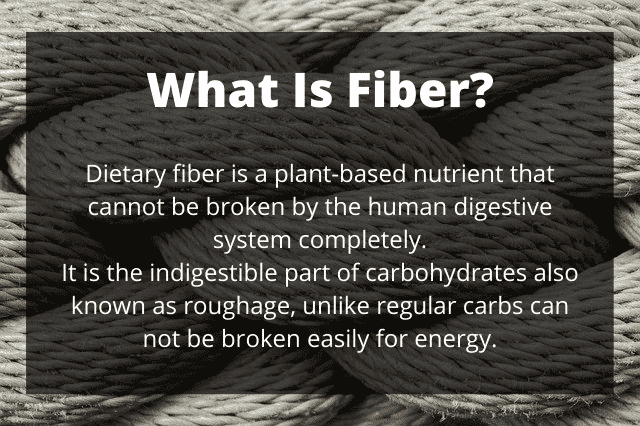
Dietary fiber is a plant-based nutrient that cannot be broken by the human digestive system completely. [1]
Fiber is the indigestible part of carbohydrates also known as roughage, unlike regular carbs can not be broken easily for energy. it passes through our digestive system unchanged and absorbing water in the way which also easing the bowel movement. [2][3]
Although fiber can not be by the human digestive system, its movement through our digestive system can have some positive impact on our body.
It is recommended that an average person should eat 30g fiber a day. [4][5]
We get dietary fiber, mainly from vegetables, fruits, legumes, whole grain. Getting enough dietary fiber can have a significant positive impact on our health, such as lower blood sugar, lower blood pressure, help to maintain a healthy weight, prevent heart diseases and some types of cancer.
Types of dietary fiber – which one is good for weight loss?
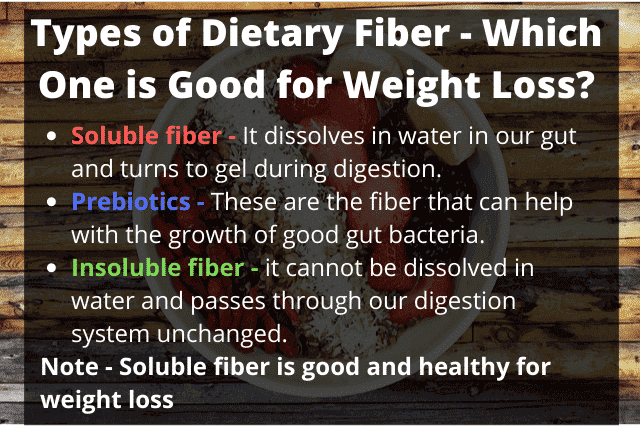
According to Colorado State University fiber can be divided into two Category – soluble fiber and insoluble fiber
Fiber is differentiated on the basis of interaction with water, soluble fiber is soluble in water and the other is not.
- Soluble fiber – It dissolves in water in our gut and turns to gel during digestion. Soluble slows down our digestion and gives us a feeling of fullness. This type of fiber is mostly found in legumes, beans, fruits, root vegetables, grains.
- Prebiotics – These are the fiber that can help with the growth of good gut bacteria.
- Insoluble fiber – it cannot be dissolved in water and passes through our digestion system unchanged. This fiber found in the walls of plant cells and cannot be fermented in the colon. This comes It helps to pass stool quickly through the stomach and intestine. It helps with constipation.
Soluble fiber is good to lose belly fat and insoluble fiber helps with bowel movement and constipation.
Fiber to weight loss – How fiber helps to lose weight?
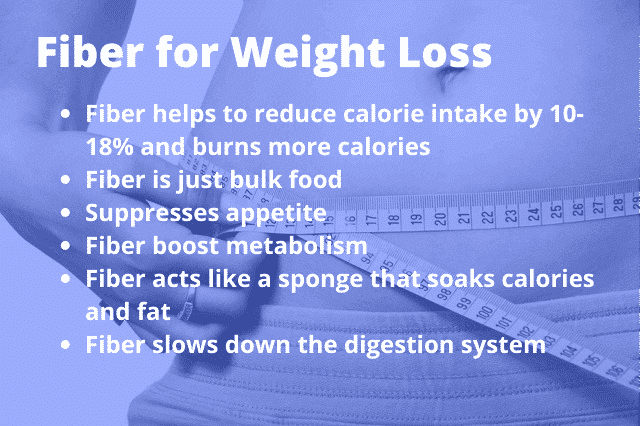
Yes, fiber can help to lose weight. You can shed some pounds of fat without doing exercise or dieting.
Several studies have shown that eating enough fiber can help with losing weight and most of us do not eat even half of the fiber for the day.
The research found that eating high fiber can help to lose weight 5 to 6 pounds more weight than those who do not eat enough.
Fiber has lots of positive effects on health that can help to lose weight such as
1. Fiber with gut bacteria
In our intestine, there are more than 100 trillion gut bacteria.
There are different kinds of bacteria and have different roles aspects of health such as weight management, immunity, blood sugar control, etc. [6][7][8][9][10]
These bacteria also need to eat healthily.
Soluble fiber passes mostly unchanged through our digestion, when it reaches our gut, some bacteria can digest it and turns it into energy.
These types of fibers are beneficial for gut bacteria. So, these are also beneficial for weight management and other health aspects. [11][12]
2. Fiber helps to reduce calorie intake by 10-18% and burns more calories
Fiber has zero calories because the human digestive system cannot utilize it, at least.
But, fiber also contributes to energy balance. Fiber has very low energy value and negative value due to the satiety effect. Soluble fiber has significant net negative energy due to the attenuating effect on absorption and digestion. [13][14][15]
By that way fiber help to burn more calories.
Eating an additional 14g/day for 2 days can decrease caloric intake by 10%. 10% of total calories are a lot of calories and you will lose almost 4-pound weight over 4 month period without doing anything. [16][17]
Even more, if you are obese your calories intakes can reduce up to 18% mean if you are obese and do not want to do exercise and dieting add more fiber to your diet.
This how fiber burns more calories and reduce calorie intake
3. Fiber is just bulk food
Fiber has zero calories. So naturally, foods are high in fiber and low in calories.
Fiber-rich foods are just bulk. It will be added to your stool and the digestive system will have to work more to process this, which also requires energy.
Fiber passes through the intestine and absorbed water which creates bulk, so the intestine muscle can push out the waste. [18] [19]
4. Fiber suppresses appetite
It is also one way to lose body weight and belly fat.
Fiber, to be specific, soluble fiber is a natural appetite suppressant. It can help you to shed some weight without doing anything.
Suppressing appetite can help you to take fewer calories. Taking fewer calories means you are creating a calorie deficit which can help you to melt fat like snow. [20]
Some studies have also found that eating more fiber can help to reduce the hunger hormone. [21] [22]
When fiber enters the stomach it stretches and makes you feel full which increases the hormones that make you feel full. [23][24][25][26]
5. Fiber boost metabolism
Fiber is indigestible carbs.
The body cannot digest fiber, but our body tried to digest fiber. In order to digest fiber, our body expends uses more calories than others. So, we use more calories to digest high-fiber foods than normal food.
Most diets and even calorie deficit slows down metabolism that why most people end up not losing weight.
A study found that eating fiber-rich food help to boost metabolism and people burn 92 calories/day more.
6. Fiber acts like a sponge that soaks calories and fat
Soluble fiber acts as a sponge soaks up water, waste, cholesterol, fat, and calories and insoluble fiber acts as a scrub brush which keeps our system clean. [27]
Fiber also swells like a sponge in the stomach, which helps to burn more calories without going to the gym. [28]
7. Fiber slows down the digestion system
Soluble fiber takes a long time to flush out. In the stomach, it reacts with water and forms a gel which increases intestinal viscosity. This is why it gives a feeling of fullness for a longer time. [29]
Soluble fiber forms a gel that slows down our digestion system and we feel full for a longer time. [30]
How much fiber should we eat a day for weight loss?
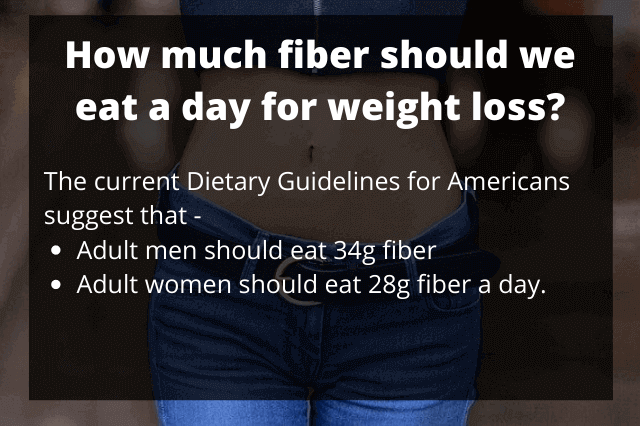
The daily fiber intake valve is not only one value. This value varies across the organization that suggests this value. Although, the difference between these values is not significant
The current Dietary Guidelines for Americans suggest that –
- Adult men should eat 34g fiber
- Adult women should eat 28g fiber a day.
The American Heart Association suggests that we should eat 25g fiber per day per 2000 calories.
Dietary guidelines 2015-2020 recommend that we should eat 14g/1000kcal fiber per day
- Female (19-30) should eat 28g fiber per day
- Male (19-30) should eat 33.6g fiber per day
- Female (31-50) should eat 25.2g fiber per day
- Male (31-50) should eat 30.8g fiber per day
It is very important to get an adequate amount of fiber (insoluble and soluble) to keep our digestive system on track. Getting enough fiber is also helps with weight loss and balancing gut bacteria.
A study published in the American Journal of Lifestyle Medicine suggests that only 5 percent of us are eating enough fiber.
A study also shows that the average American eats only 16g fiber per day, which is way lower than the daily recommended value.
10 foods with the highest soluble fiber content for weight loss
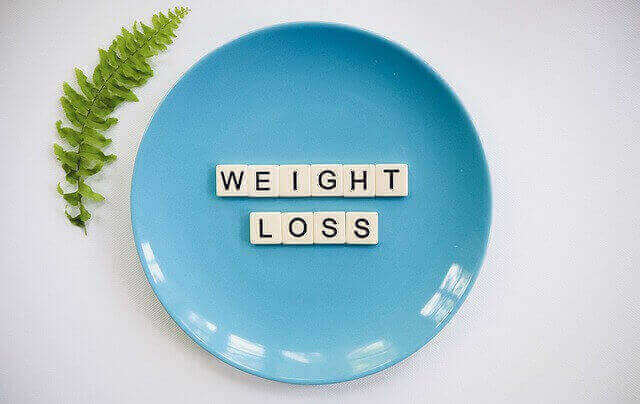
Fiber has lots of health benefits. But, soluble fiber is very beneficial for weight loss. It is good for gut bacteria, suppresses appetite, boosts metabolism, decreases calorie intake.
So, here are 10 foods with the highest soluble fiber content, according to Dietitians of Canada –
1. Black beans (5.4g soluble fiber per 129g)
Black beans are one of the greatest sources of fiber.
Just one cup (172g) black beans contain around 15g fiber content which is almost 40% of the RDA for men. But it also contains lots of soluble fiber.
Black beans can delay emptying the stomach and give a fuller feeling for a longer time.
Soluble fiber – 5.4 g per ¾ cup (129g)
2. Lima Beans (5.3g soluble fiber per 128g)
Lima beans are known as butter bean or Madagascar bean.
Just 100g lima beans contain 21g carbohydrates from which 7g total fiber, and 7.8g protein.
It also contains lots of vitamins and minerals such as Manganese, Magnesium, Iron, Folate (B9), Vitamin B6, etc. [31]
Soluble fiber – 5.3 g per ¾ cup (128g)
3. Soy nuts (3.5g soluble fiber per 50g)
Soy nuts are crunchy and delicious snacks made with mature soybean soaked, drained and roasted.
They can be used in place of high protein and fiber products.100g soy nuts contain 30g carbs, 38g protein, and 18g fiber. But for weight loss soluble fiber is more beneficial and it also contains lots of it.
Soluble fiber – 3.5 g per 50g
4. Navy beans, (3.5g soluble fiber per 150g)
Navy beans are the variety of common beans (Phaseolus vulgaris).
It is a small, dry white bean and has a slightly flattened shape.
Just 100g of navy beans contain 10.5g fiber, which is about 30-40% of the RDA value for fiber. These are also rich in navy blue.
Soluble fiber – 3.5 g per ¾ cup (150g)
5. Pinto beans (3.2g soluble fiber per 150g)
It is also a variety of common bean. It is most popular in the United States and northwestern.
1 cup of Pinto beans contains 15.4g fiber, which is about 50% of the RDA value of fiber for women.
Soluble fiber – 3.2 g per ¾ cup (150g)
6. Kidney beans (3.0g soluble fiber per 133g)
The kidney bean is a variety of Phaseolus vulgaris, also known as a common bean.
The kidney beans are a great source of protein. 100g kidney bean contains 9g protein and 6.4g fiber.
Kidney beans also contain lots of soluble fiber, which is essential for weight loss.
Soluble fiber – 3.0 g per ¾ cup (133g)
7. Bran Buds with Psyllium (2.7g soluble fiber per 30g)
All-Bran Buds are manufactured by Kellogg’s. It is low in calories and high fiber. It is available in the United States and Canada.
A ⅓ cup serving contains 2.7g soluble fiber and 10g insoluble fiber.
Soluble fiber – 2.7 g per ¾ cup (30g)
8. Oat bran (2.2g soluble fiber per 160g)
Oat bran is one of the healthiest grains that is packed with vitamins and minerals.
It is the outer layer of the oat groat under the inedible hull.
One cup of oat bran contains 6g fiber and 25g carbs.
Soluble fiber – 2.7 g per ¾ cup (160g)
9. Avocado (2.1g soluble fiber per ½ fruit)
Avocado is one of the healthiest foods on earth. It is a green-skinned, fleshy body and egg-shaped. Avocado primarily contains lots of healthy fats and carbohydrates.
100g avocado contains 8.5g carbs, 15g protein, and 6.7g fiber.
Soluble fiber – 2.1 g per half fruit (128g)
10. Brussels sprouts (2g soluble fiber per 78g)
Brussels sprout is a member of the Gemmifera Group of cabbages.[32]
It is also a great source of fiber it contains 4g fiber per cup.
Soluble fiber – 2 g per ½ cup (78g)
Bottom line
Dietary fiber is very beneficial for health.
It helps to improve the health of gut bacteria and fermentable fiber also form a short chain of fatty acids.
More than that dietary fiber helps to maintain and reduce weight by suppressing appetite, slow down digestion, boosting metabolism and helping with gut bacteria.
It is recommended that for general benefits and significant weight loss an adult person should eat 28-38 g fiber per day depending on age, sex, etc.
Vegetables, fruits, grains, and legumes are the best sources to get soluble fiber or fiber in general.
Most frequently asked Question
Does fiber help to lose weight?
Yes, fiber can help to lose weight. Fiber helps with gut bacteria, reduces calorie intake by 10-18%, suppresses appetite, boost metabolism, slow down digestion and by soaking calories and fat.
How much fiber should I eat a day to lose weight?
The current Dietary Guidelines for Americans suggest that an Adult men should eat 34g fiber and 28g fiber a day for women. This amount of fiber is enough to lose noticeable weight.
Which fiber is good for weight loss?
Soluble fiber is beneficial to weight loss and insoluble fiber for bowel movement and constipation.
Which food has the highest soluble fiber content?
Soluble fiber is beneficial for weight loss. Legumes, vegetables, green leafy vegetables, fruits are the main source of fiber. Top 5 foods with highest soluble fiber are Black beans, Lima beans, Soy nuts, navy beans, and pinto beans.
How much weight you can lose by eating fiber?
It depends on your body, sex, and age. But, the research found 1 pounds weight per month by just eating 14g additional fiber for two days.
- Nutrition Australia “Fiber” “https://www.nutritionaustralia.org/sites/default/files/Fibre-2014.pdf”
- Internet Archive “Dietary reference intakes for energy, carbohydrate, fiber, fat, fatty acids, cholesterol, protein, and amino acids” “https://archive.org/details/isbn_9780309085250”
- The National Academies of Sciences, Engineering, Medicine “Dietary Reference Intakes for Energy, Carbohydrate, Fiber, Fat, Fatty Acids, Cholesterol, Protein, and Amino Acids” “https://www.nap.edu/catalog/10490/dietary-reference-intakes-for-energy-carbohydrate-fiber-fat-fatty-acids-cholesterol-protein-and-amino-acids”
- NCBI “Trends in dietary fiber intake in the United States, 1999-2008.” “https://www.ncbi.nlm.nih.gov/pubmed/22709768”
- Health.gov “Nutritional Goals for Age-Sex Groups Based on Dietary Reference Intakes and Dietary Guidelines Recommendations” “https://health.gov/dietaryguidelines/2015/guidelines/appendix-7/”
- NCBI “A randomized trial of single- versus multi-component dietary goals for metabolic syndrome” “https://www.ncbi.nlm.nih.gov/pmc/articles/PMC4456033/”
- NCBI “Gut flora in health and disease.” “https://www.ncbi.nlm.nih.gov/pubmed/12583961”
- NCBI “Microbial ecology: human gut microbes associated with obesity.” “https://www.ncbi.nlm.nih.gov/pubmed/17183309”
- NCBI “Obesity, diabetes, and gut microbiota: the hygiene hypothesis expanded?” “https://www.ncbi.nlm.nih.gov/pubmed/20876708”
- NCBI “Who controls the crowd? New findings and old questions about the intestinal microflora.” “https://www.ncbi.nlm.nih.gov/pubmed/15894105”
- Wiley Online Library “The microbiome‐gut‐brain axis: from bowel to behavior” “https://onlinelibrary.wiley.com/doi/full/10.1111/j.1365-2982.2010.01664.x”
- NCBI “The Role of Fiber in Energy Balance” “https://www.ncbi.nlm.nih.gov/pmc/articles/PMC6360548/#sec7title”
- NCBI “Dietary fiber and weight regulation.” “https://www.ncbi.nlm.nih.gov/pubmed/11396693”
- Oxford Acadamic “Dietary Fiber and Weight Regulation” “https://academic.oup.com/nutritionreviews/article/59/5/129/1875096”
- NCBI “What is the Required Energy Deficit per unit Weight Loss?” “https://www.ncbi.nlm.nih.gov/pmc/articles/PMC2376744/”
- International Journal of Obesity “What is the required energy deficit per unit weight loss?” “https://www.nature.com/articles/0803720”
- NCBI “Fiber intake predicts ghrelin levels in overweight and obese postmenopausal women.” “https://www.ncbi.nlm.nih.gov/pubmed/19369431”
- EJE “Fiber intake predicts ghrelin levels in overweight and obese postmenopausal women” “https://eje.bioscientifica.com/view/journals/eje/161/1/65.xml”
- NCBI “Low-Fat Versus Low-Carbohydrate Weight Reduction Diets” “https://www.ncbi.nlm.nih.gov/pmc/articles/PMC2780863/”
- Mayo Clinic “Dietary fiber: Essential for a healthy diet” “https://www.mayoclinic.org/healthy-lifestyle/nutrition-and-healthy-eating/in-depth/fiber/art-20043983”
- umass.edu “Fiber” “https://www.umass.edu/nibble/infofile/fiber.html”
- NCBI “Beans, as a source of dietary fiber, increase cholecystokinin and apolipoprotein b48 response to test meals in men.” “https://www.ncbi.nlm.nih.gov/pubmed/11340104”
- Oxford Academic “Beans, as a Source of Dietary Fiber, Increase Cholecystokinin and Apolipoprotein B48 Response to Test Meals in Men” “https://academic.oup.com/jn/article/131/5/1485/4686932”
- NCBI “Gut microbiota fermentation of prebiotics increases satietogenic and incretin gut peptide production with consequences for appetite sensation and glucose response after a meal.” “https://www.ncbi.nlm.nih.gov/pubmed/19776140”
- Oxford Academic “Gut microbiota fermentation of prebiotics increases satietogenic and incretin gut peptide production with consequences for appetite sensation and glucose response after a meal” “https://academic.oup.com/ajcn/article/90/5/1236/4598107”
- NCBI “Substituting whole grains for refined grains in a 6-wk randomized trial favorably affects energy-balance metrics in healthy men and postmenopausal women.” “https://www.ncbi.nlm.nih.gov/pubmed/28179223”
- Betterhealth.gov “Fibre in food” “https://www.betterhealth.vic.gov.au/health/healthyliving/fibre-in-food”
- NCBI “Effects of Dietary Fiber and Its Components on Metabolic Health” “https://www.ncbi.nlm.nih.gov/pmc/articles/PMC3257631/#__sec17title”
- Health.gov “DIETARY GUIDELINES FOR AMERICANS 2015-2020 EIGHTH EDITION” “https://health.gov/dietaryguidelines/2015/resources/2015-2020_Dietary_Guidelines.pdf”
- Heart.org “Whole Grains, Refined Grains, and Dietary Fiber” “https://www.heart.org/en/healthy-living/healthy-eating/eat-smart/nutrition-basics/whole-grains-refined-grains-and-dietary-fiber#.WVVm4RMrIdU”
- NCBI “Closing America’s Fiber Intake Gap” “https://www.ncbi.nlm.nih.gov/pmc/articles/PMC6124841/”
- Wikipedia “Brussels sprout” “https://en.wikipedia.org/wiki/Brussels_sprout”
- Healthline “9 Health and Nutrition Benefits of Oat Bran” “https://www.healthline.com/nutrition/oat-bran”
- Wikipedia “Bran Buds” “https://en.wikipedia.org/wiki/Bran_Buds”
- Carleton university “Food Sources of Soluble Fibre” “https://carleton.ca/healthy-workplace/wp-content/uploads/soluble-fibre.pdf”